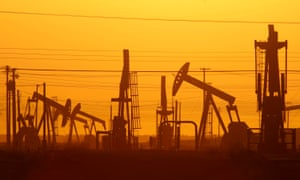Trump plans to allow fracking near California’s national parks
The Guardian
Environmental groups are preparing for a fight against the proposal that would end a five-year fracking moratorium in central California

The Trump administration has issued a plan to open more than a million acres in California to fracking, including areas close to Yosemite, Kings Canyon and Sequoia national parks.
In its proposal, the government made a case that the effects on a range of delicate issues – from degrading air quality to threats to cultural and Native American resources in the area – could be avoided or minimized on 1,011,470 acres across eight counties. The plan could end a five-year fracking moratorium in California enforced by a federal judge.
Environmental groups are planning to put up a fight. “We will push back every step of the way against this reckless plan to subject more of California’s lands, wildlife, and communities to fracking,” Monica Embrey, a senior campaign representative at the Sierra Club, said in a statement.
Making good on a campaign promise, Donald Trump has attempted to lift environmental regulations on federal lands across the country and has vowed to increase America’s energy independence by opening up drilling domestically. This has put him directly at odds with California leaders, who are are pursuing a greener future.
In 2018, when the administration first rolled back regulations to make way for new leasing opportunities, California’s attorney general, Xavier Becerra, called the repeal a “federal overreach” and vowed to resist increased fracking in the state. “The risks of fracking to our health and to our environment are real … from the evaporation of toxic chemicals, to low-level seismic events, to the contamination of our drinking water.”
Maps included in the report, which outline potential areas where fracking leases could be most fruitful, highlight swaths of land that border national parks and national forests. The boundaries are just south of Yosemite and bump up to the edge of Sequoia national forest. Advocates at the National Parks Conservation Association (NPCA) claim the scope of the proposal falls within two miles of that park.
“The risks posed to our national parks by further oil and gas development, particularly these iconic treasures that helped to inspire the modern-day conservation movement, is saddening to say the least,” said Mark Rose, a field representative with NPCA. “Yosemite, Sequoia and Kings Canyon already experience some of the worst air quality within the park system, posing unprecedented threats to visitors and the natural resources that call these places home.”
There will be a 45-day period for the public to weigh in on the new plan. Environmental groups have called on California’s governor, Gavin Newsom, to ban all new fracking in the state, pointing to research from the California Council on Science and Technology, which found that fracking can poison drinking water with toxic chemicals. Another study, released in 2017, revealed that pollutants from the process can harm infants and children. Fracking has been banned in many European countries, including France, Germany and Ireland.
The government report states that additional fracking wells might require 80m gallons of water a year, even though some residents in the area face drinking water shortages.
Since you’re here…
… we have a small favour to ask. More people are reading and supporting our independent, investigative reporting than ever before. And unlike many news organisations, we have chosen an approach that allows us to keep our journalism accessible to all, regardless of where they live or what they can afford.
The Guardian is editorially independent, meaning we set our own agenda. Our journalism is free from commercial bias and not influenced by billionaire owners, politicians or shareholders. No one edits our editor. No one steers our opinion. This is important as it enables us to give a voice to those less heard, challenge the powerful and hold them to account. It’s what makes us different to so many others in the media, at a time when factual, honest reporting is critical.
Every contribution we receive from readers like you, big or small, goes directly into funding our journalism. This support enables us to keep working as we do – but we must maintain and build on it for every year to come. Support The Guardian from as little as $1 – and it only takes a minute. Thank you.

.png)







Follow Us!